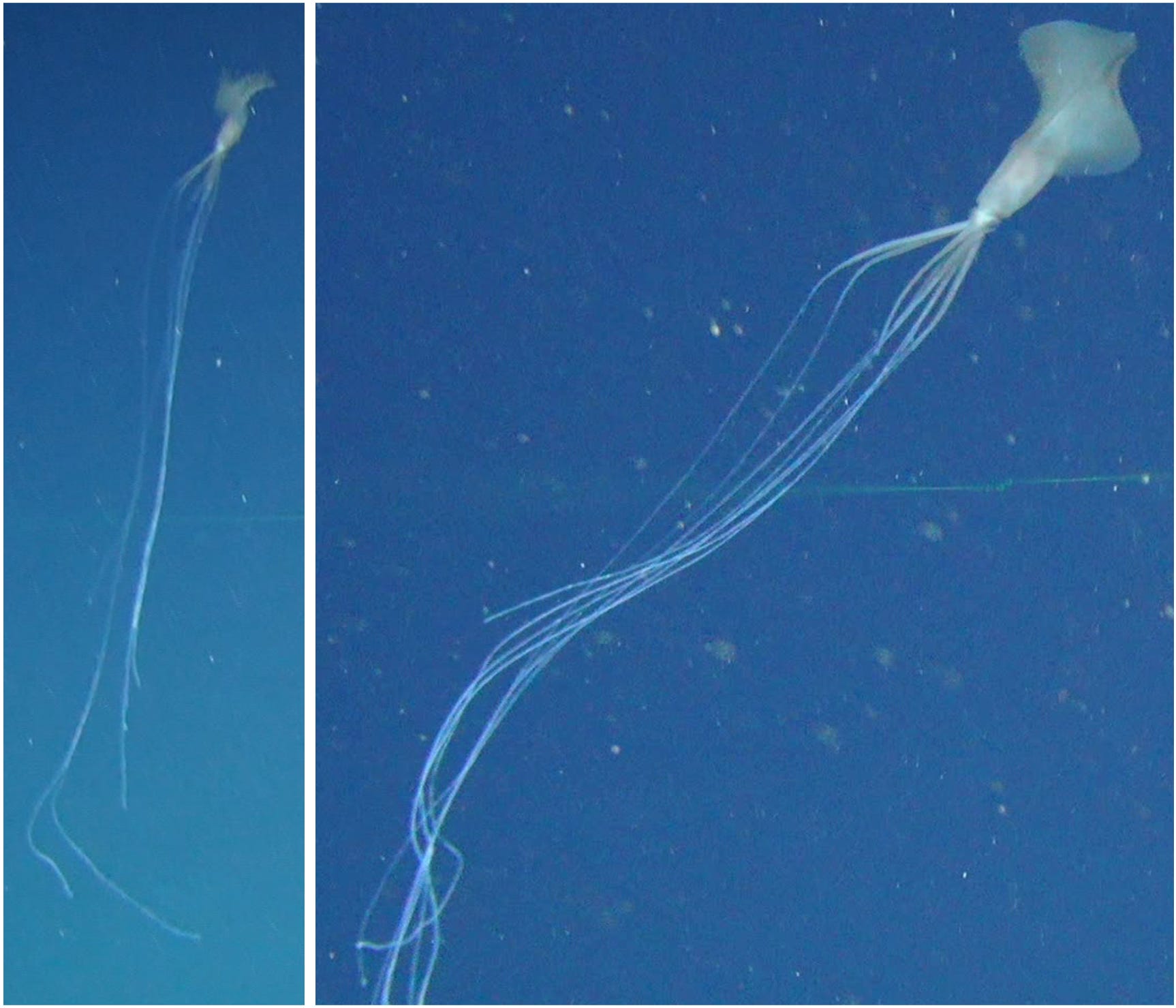
Courtesy of Deborah Osterhage/CSIRO
- Bigfin squid have tentacles 11 times longer than their bodies.
- The creatures are camera shy: They’ve only been spotted a dozen times since the 1980s.
- Scientists recently captured new, underwater footage of five bigfin squid off the coast of southern Australia — the first time they’ve been spotted in Australian waters.
- Visit Business Insider’s homepage for more stories.
The squid was dragging long, spaghetti-like tentacles and using fins like elephant ears to propel itself through the dark waters.
Marine scientist Deborah Osterhage spotted it in footage collected from cameras on remotely operated vehicles that had scoured Australia’s Great Bight — a bay off the continent’s southern coast. The creature was swimming 2 miles under the surface.
“I recognized it immediately, with its distinctive large fins and extremely long and slender arms and tentacles, which were bent a little like an elbow,” Osterhage told Business Insider.
The animal was a bigfin squid, or magnapinnidae: a camera-shy cephalopod rarely seen by humans. It had never been spotted in Australian waters before.
—Aylin Woodward (@AylinWoodward) November 13, 2020
In a study published last week in the journal PLOS One, Osterhage and her team describe how they captured footage of five of these rare squid in Australia, and what the sightings reveal about the creatures’ anatomy.
The videos enabled the researchers to make an unprecedentedly accurate measurement of the squid's body and tentacles.
"The fact that they have been rarely observed makes these sightings very special. Up until now, only around a dozen have been filmed over a period of 30 years, so seeing five in the Great Australian Bight is very exciting," Osterhage said.
The squid's tentacles are 11 times longer than its body
Osterhage's team, part of Australia's Commonwealth Scientific and Industrial Research Organization, wasn't specifically looking for bigfin squid. They were simply trying collect footage of the Bight's thousands of marine species by towing underwater cameras behind a research vessel.
Then two squid showed up in the footage.
So the team organized a second voyage to the Bight, this time using remotely operated vehicles (ROVs). That way, they could better control what the cameras filmed and pause if they found a species on their "critter hotlist," Osterhage said.
That research revealed three more bigfin squid.
—Aylin Woodward (@AylinWoodward) November 13, 2020
Although the encounters lasted only minutes, that was long enough for the researchers to measure one of the animals using two laser pointers mounted on the ROV. It measured more than 5.9 feet (1.8 meters) long, with its body making up just 6 inches of that total.
"The arms and tentacles were around 11 times the mantle length, which is not what is typically seen in squid," Osterhage said.
By contrast, the giant squid has a mantle, or body, around 8 feet (2.5 meters) with tentacles four times that length.

Courtesy of Deborah Osterhage/CSIRO
Bigfin squid get their name from the bulbous fins that jut out from their bodies. The fins are about as wide as the body is long, according to Osterhage. But it's the body-to-tentacle proportion that makes these squid unique.
Another neat feature: the squid like to flex.
Most cephalopods' tentacles dangle below their mantles, but a bigfin's bend — that's why Osterhage was able to spot the animal so easily in the footage.
5 squid clustered in close proximity
All told, Osterhage's team collected 40 hours of underwater footage at depths between 0.6 miles and 2 miles (946 meters and 3,258 meters).
The five squid were all spotted in about the same place: "They were clustered in close proximity of each other in time and space," Osterhage said.
The study authors confirmed, though, that they'd seen five different squid, not the same one. That was a deviation from previous sightings, which had mostly involved individual squid.
"Clustering like this could indicate habitat preference, a gathering for reproduction, or even effects of currents," Osterhage said, adding, "further sightings will help us figure out this puzzle."

Courtesy of Deborah Osterhage/CSIRO
Given the paucity of bigfin squid sightings, researchers still don't know how they reproduce or feed — none have deigned to nosh on camera.
"Because their long arms and tentacles are retractable and sticky, some scientists believe they may use them to 'fish' for their food, possibly plankton," Osterholm said.
The largest bigfin squid ever spotted was 23 feet long
French scientists reported the first-ever bigfin sighting nearly 120 years ago, when a fisherman caught one near the Azores. The squid weren't caught on camera in their deep-sea habitat until 1988, when researchers encountered one 2.9 miles underwater, off Brazil's northern coast.

Courtesy of Deborah Osterhage/CSIRO
According to Osterhage, the squid can be found at depths of more than 3 miles. So far, they've been spotted in the southern Caribbean, Indian Ocean, Gulf of Mexico, Pacific Ocean near Hawaii, and off the shores of western Africa.
Of the 12 or so bigfin squid ever seen, the largest was 23 feet (7 meters) long.
